The NVIDIA GeForce GTX 750 Ti and GTX 750 Review: Maxwell Makes Its Move
by Ryan Smith & Ganesh T S on February 18, 2014 9:00 AM ESTOverclocking: When Headroom Exceeds Clockspeed Limits
Last but not least we have our customary look at overclocking performance. With all 3 of our cards being based on the same reference design, we expect to see some relatively consistent results between the cards. At the same time NVIDIA has told us that GTX 750 has some very interesting overclocking properties, and boy they weren’t kidding.
On a quick note, as a GPU Boost 2.0 product, overclocking on the GTX 750 series is not any different than on other GTX 700 series cards. It’s still based on offset overclocking, with the user adjusting offsets for the final overclock. But with that said there are two things to point out. The first is that the power target is limited to 100% on all cards. Because these are sub-75W cards, NVIDIA is not allowing anyone to exceed the card’s default TDP, so you only have as much power to play with as you started with. Second of all, none of our cards had available overvoltage bins. Apparently some cards do, but ours did not, so our voltage bins maxed out at the default bins you see listed.
Finally, all 3 cards have a maximum clock offset of 135MHz. This will be an important fact in a little bit.
| GeForce GTX 750 Series Overclocking | |||||
| GTX 750 Ti (Ref) | Zotac GTX 750 Ti | Zotac GTX 750 | |||
| Shipping Core Clock | 1020MHz | 1033MHz | 1033MHz | ||
| Shipping Max Boost Clock | 1150MHz | 1175MHz | 1163MHz | ||
| Shipping Memory Clock | 5.4GHz | 5.4GHz | 5.0GHz | ||
| Shipping Max Boost Voltage | 1.168v | 1.137v | 1.187v | ||
| Overclock Core Clock | 1155MHz | 1168MHz | 1168MHz | ||
| Overclock Max Boost Clock | 1285MHz | 1310MHz | 1298MHz | ||
| Overclock Memory Clock | 6.3GHz | 6.1GHz | 6.0GHz | ||
| Overclock Max Boost Voltage | 1.168v | 1.137v | 1.187v | ||
As we can quickly see, two patterns emerge. The first is that with every card equipped with 6GHz memory (though we remain unsure which mode the Zotac GTX 750’s is in), each and every card hits at least 6GHz, and sometimes a bit more. With the 128-bit memory bus generally providing the biggest bottleneck for GM107, the fact that there is 12%+ overclocking headroom here is going to be very helpful in feeding the tiny beast that is GM107.
More significantly however is the core overclock. We maxed out every single one. Every card, from the NVIDIA reference card to the Zotac cards, had no trouble overclocking by the full 135MHz to their respective maximum overclocks. The Zotac GTX 750 Ti, having the highest maximum boost clock by default, is technically the winner here at 1310MHz. But at this point everyone is a winner. Going by the maximum boost clock, every card is capable of an 11% core overclock, to go with that tasty 12% memory overclock.
The fact of the matter is that this is not something we normally encounter. Sub-75W cards are not poor overclockers, but they’re not usually strong overclockers either, which is why a 135MHz offset limit makes sense at first glance. But it’s clear that NVIDIA underestimated their own overclocking potential here when setting the specifications for these cards, as there’s seeming some headroom left untapped. Without additional offset room it’s impossible to say just how much more overclocking headroom remains – it may not be very much – but there should be room for at least some additional overclocking.
At this point with cards already in the pipeline we’ll have to take a look at individual cards and see what manufacturers have set their offset limits at. If they have followed NVIDIA’s specifications, then they’ll be equally limited. But hopefully with the launch now behind them, NVIDIA’s partners can work with NVIDIA on making greater offsets available on newer batches of cards.
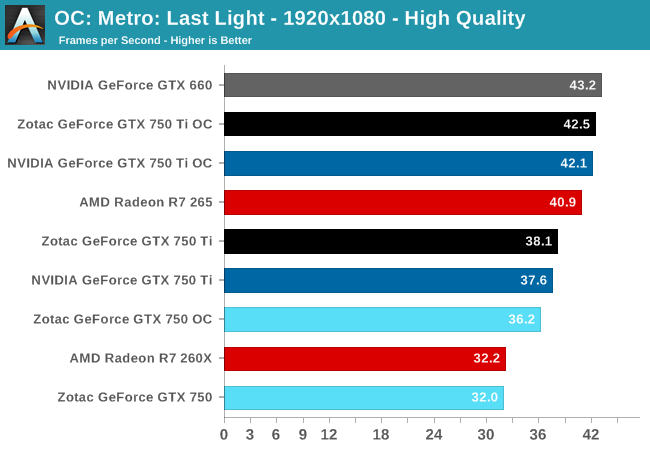
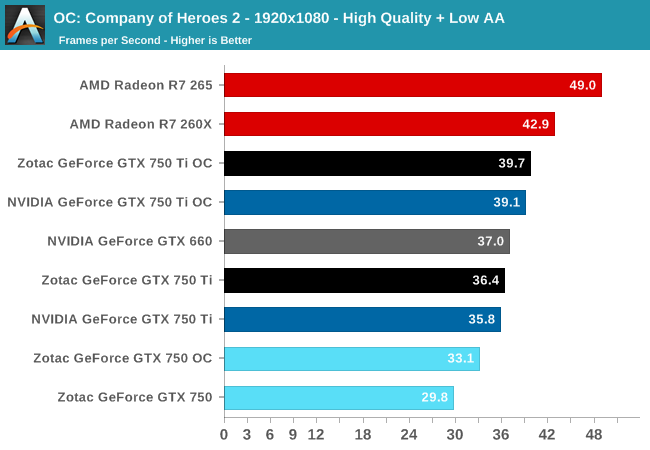
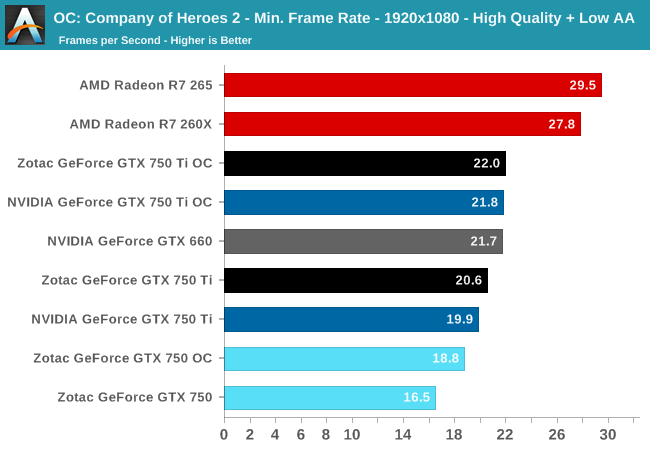

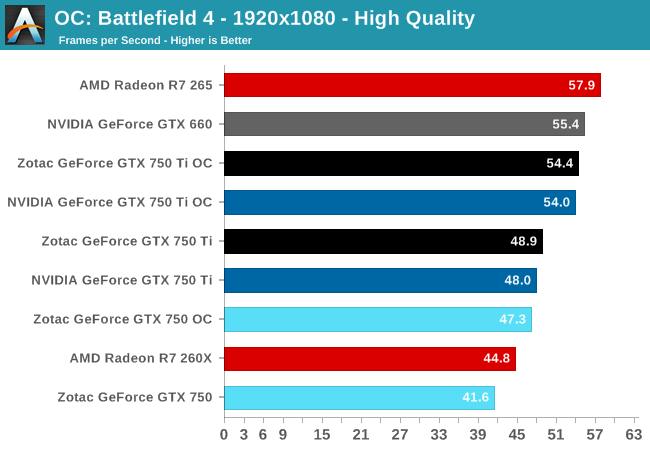
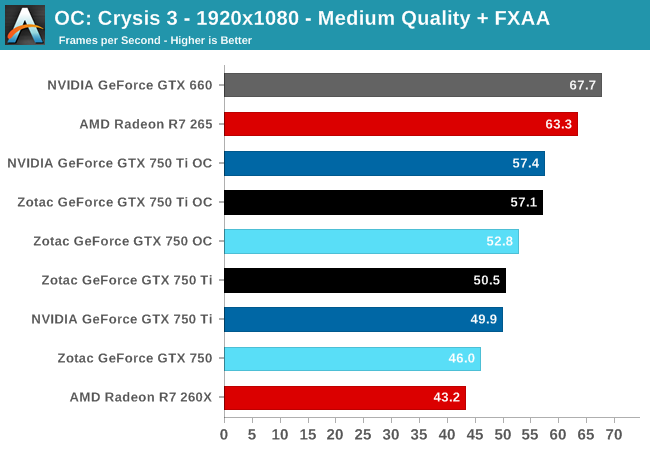
Depending on the game being used, the benefits from overclocking range from 9% to 12%, roughly in-line with our overclocks. For the GTX 750 this is sometimes enough to catch the stock clocked R7 260X, but even with this overclock the GTX 750 Ti will still generally trail the R7 265.
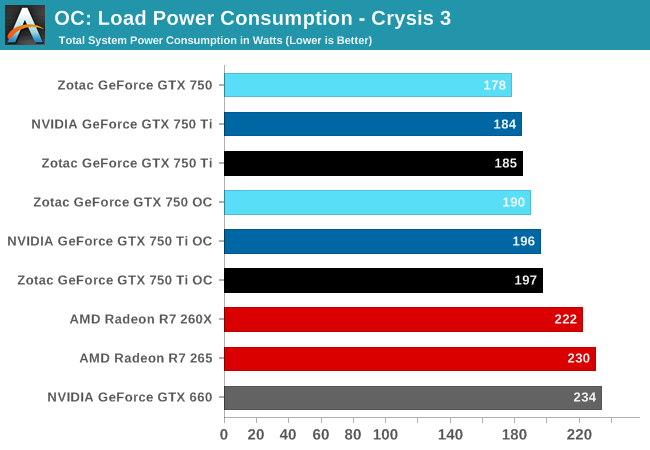

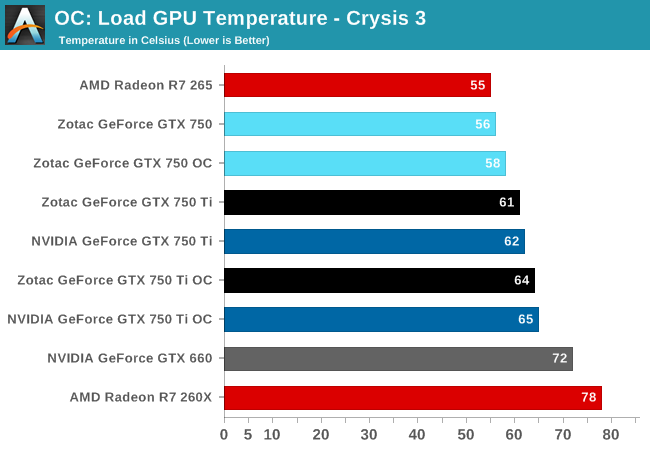
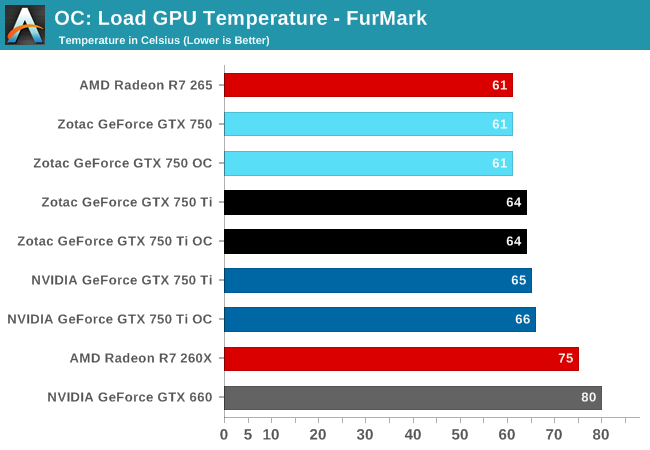
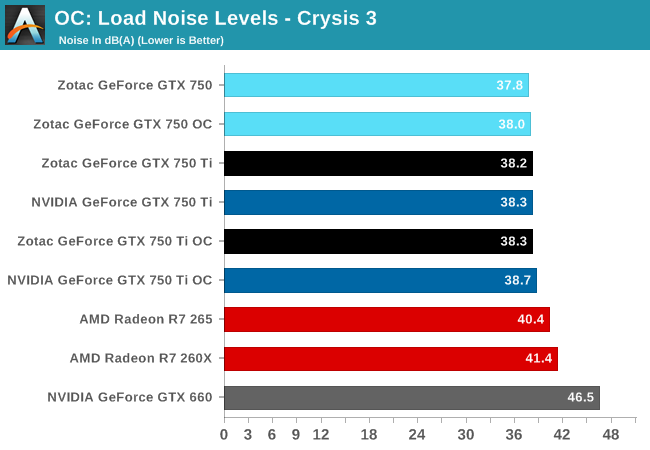
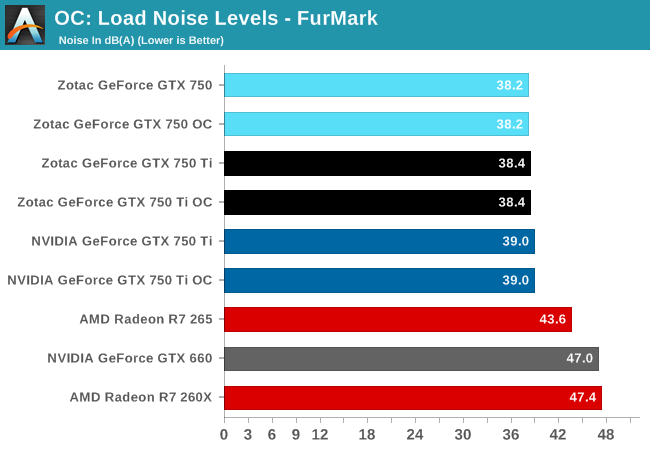
On the other hand, because of the hard TDP limit of 100%, this extra performance is relatively cheap. Video card power consumption moves by only a few watts, and then a few watts of CPU time on top of that. For all practical purposes overclocking can extend NVIDIA’s already incredible performance-per-watt ratio by another 10% with no meaningful impact on noise. Given the consistency of overclocking headroom we’ve seen in our GTX 750 series samples, this is one of those scenarios where overclocking is going to be a reasonable and (relatively) fool proof action to take.










177 Comments
View All Comments
Mondozai - Wednesday, February 19, 2014 - link
Anywhere outside of NA gives normal prices. Get out of your bubble.ddriver - Wednesday, February 19, 2014 - link
Yes, prices here are pretty much normal, no on rushes to waste electricity on something as stupid as bitcoin mining. Anyway, I got most of the cards even before that craze began.R3MF - Tuesday, February 18, 2014 - link
at ~1Bn transitors for 512Maxwell shaders i think a 20nm enthusiast card could afford the 10bn transistors necessary for a 4096 shaders...Krysto - Tuesday, February 18, 2014 - link
If Maxwell has 2x the P/W, and Tegra K2 arrives at 16nm, with 2 SMX (which is very reasonable expection), then Tegra K2 will have at least a 1 Teraflop of performance, if not more than 1.2 Teraflops, which would already surpass the Xbox One.Now THAT's exciting.
chizow - Tuesday, February 18, 2014 - link
It probably won't be Tegra K2, will most likely be Tegra M1 and could very well have 3xSMM at 20nm (192x2 vs. 128x3), which according to the article might be a 2.7x speed-up vs. just a 2x using Kepler's SMX arch. But yes, certainly all very exciting possibilities.grahaman27 - Wednesday, February 19, 2014 - link
the Tegra M1 will be on 16nm finfet if they stick to their roadmap. But, since they are bringing the 64bit version sooner than expected, I dont know what to expect. BTW, it has yet to be announce what manufacturing process the 64bit version will be... we can only hope TSMC 20nm will arrive in time.Mondozai - Wednesday, February 19, 2014 - link
Exciting or f%#king embarrassing for M$? Or for the console industry overall.RealiBrad - Tuesday, February 18, 2014 - link
Looks to be an OK card when you consider that mining has caused AMD cards to sell out and push up price.It looks like the R7 265 is fairly close on power, temp, and noise. If AMD supply could meet demand, then the 750Ti would need to be much cheaper and would not look nearly as good.
Homeles - Tuesday, February 18, 2014 - link
Load power consumption is clearly in Nvidia's favor.DryAir - Tuesday, February 18, 2014 - link
Power consumpion is way higher... give a look at TPU´s review. But price/perf is a lot beter yeah.Personally I'm a sucker for low power, and I will gadly pay for it.